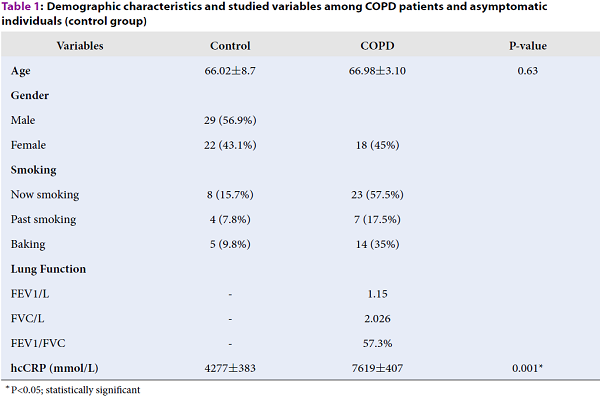Evaluating serum C-reactive protein level in patients with chronic obstructive pulmonary disease and its correlation with disease severity
DOI:
https://doi.org/10.15419/bmrat.v5i11.494Keywords:
CRP, Iran, Pulmonary disease, SmokingAbstract
Background: It has been proven that patients with chronic obstructive pulmonary disease (COPD) are at risk for increased atherothrombotic events. Studies have demonstrated that C-reactive protein (CRP) and COPD are risk factors for heart disease. The present study aimed to evaluate the serum level of CRP in patients with COPD and compare it with those of the control group.
Method: The present case-control study was conducted on 40 patients with COPD and 51 asymptomatic individuals (control subjects). High-sensitivity C-reactive protein (hsCRP), blood gases, and spirometry were evaluated in patients with COPD and compared with those of the control group.
Results: Patients with COPD had a higher hsCRP than the control group, and the difference was statistically significant (7.6 mg/L compared to 4.2 mg/L, P<0.001). A negative correlation was found between hsCRP and the predicted percentage of forced expiratory volume in one second (FEV1%) (P=0.03; r=0.32). There was also a positive correlation between hsCRP and the severity of COPD based on the Global Initiative for Chronic Obstructive Lung Disease (GOLD) criteria (P=0.04; r=0.3).
Conclusion: Serum hsCRP is higher in the COPD group than the control group matched based on age, and hsCRP is correlated with the severity of COPD. Further studies with larger sample sizes are required for evaluating this correlation in patients with COPD.

Downloads
Published
Issue
Section
License
Copyright The Author(s) 2017. This article is published with open access by BioMedPress. This article is distributed under the terms of the Creative Commons Attribution License (CC-BY 4.0) which permits any use, distribution, and reproduction in any medium, provided the original author(s) and the source are credited.
